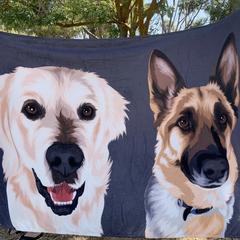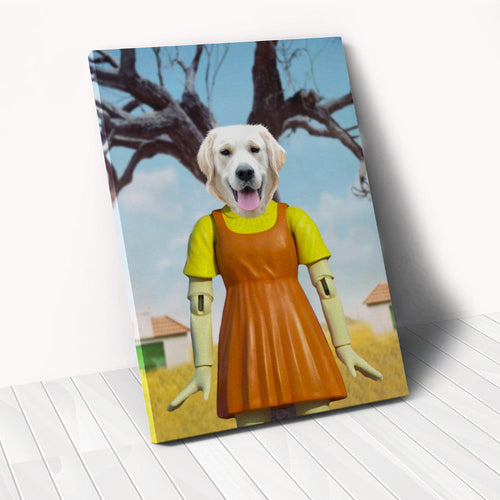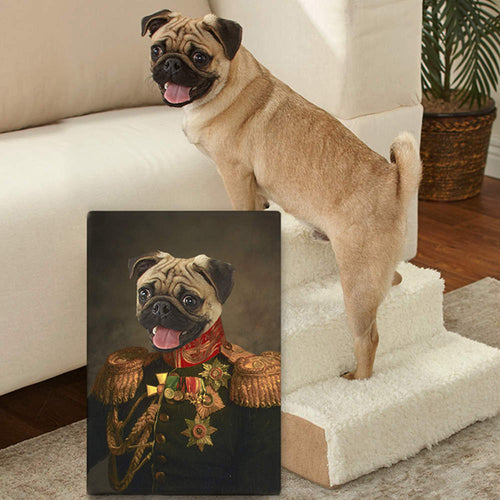
Deaf Dog Training
Is your dog experiencing hearing loss, making communication a challenge? Do not worry we have got you covered. Training a deaf dog comes with its own set of challenges and rewards. In this guide to deaf dog training you will learn effective strategies, important hand signals, and updated safety procedures to help you and your deaf canine companion.
How to Train a Deaf Dog?
Training a deaf dog involves several effective techniques. Here are the most helpful methods:
Lure Training
The lure training method uses treats and praise as motivation. In this training, you begin by holding a treat in front of your dog's nose to capture their attention. Then slowly move the treat over their head, encouraging them to sit and keep their focus on the treat.
Mark and Reward Training
This technique involves associating hand gestures with rewards. For example, you can use a thumbs-up or a hand clap as a signal. You can teach your dog to connect this gesture with a positive outcome, rewarding them immediately when they perform the desired action during training.
Startle Training
Touching a deaf dog unexpectedly, especially when they are sleeping, can startle them initially. Therefore, startle training is used so that your deaf dog does not get scared when you touch or approach them. Touch your dog gently in the same spot while they are awake, and then give them a tasty treat right away. Afterwards, move slightly out of your dog's sight and repeat the process. As your dog gets more comfortable, you can gradually use a firmer touch.
What Hand Signals Are Essential for Deaf Dog Training?
Here are 12 common hand signals which are essential for deaf dog training:
1. Sit
To start, hold your hand in front of you with your palm facing up, and gently raise your hand towards your shoulder to signal "sit."
2. Lay Down
For "lay down," begin with your hand up near your shoulder and smoothly lower your hand towards the ground, mimicking the desired action.
3. Wait
You can signal "wait" by extending your hand forward at waist height, palm facing forward, to help your dog learn impulse control.
4. Come
Encourage your dog to come by starting with your hand at your side and your palm facing up. Then move your hand up towards the opposite shoulder.
5. Up
Prompt your dog to raise their front paws and sit back on their hind legs by moving your outstretched hand upwards from your waist to your shoulders.
6. Spin
For a playful "spin" cue, extend your hand in front of you and create a circular motion with a pointed finger to keep your dog engaged.
7. High Five
To teach this crouch down to your dog's level and extend your palm toward them, similar to asking a person for a high five.
8. Roll Over
Guide your dog to "roll over" with a hand signal that mirrors the desired movement—extend your arm and hand in front of you, then move it in an arc motion.
9. Crawl
Teach your dog to "crawl" using a hand signal by crouching a bit lower and holding your hand low to guide them where you want them to move.
10. Fetch
Sharpen your dog's focus with a "fetch" cue by pointing your finger forward, starting at your side and raising it to direct them to retrieve an object.
11. Drop
Signal "drop" by pointing your finger and hand towards the floor when you want your dog to release an object.
12. Stay
Communicate "stay" by holding your hand with the palm facing your dog, maintaining the desired position until you're ready to release them. Teaching your dog to stay is vital, especially in busy or noisy environments, to ensure their safety.
How Can I Teach My Deaf Dog the “Watch Me” Cue?
To teach your deaf dog the "Watch Me" cue, follow these steps:
- Try getting your dog's attention using a high-value treat or a favorite toy.
- Hold the treat or toy near your eyes, and when your deaf dog looks at you, use a visual marker like a hand signal or sign for "yes" and give them a reward. Repeat this several times.
- Once your dog understands the connection between looking at you and getting a reward, introduce a hand signal (e.g., pointing to your eyes) while repeating the exercise.
- Progress to the final step by extending your arm to the side and asking for the "look" cue. When your dog looks at your eyes instead of the treat or toy, use your marker and reward with a high-value treat.
Practice this exercise regularly to reinforce the "Watch Me" cue. You can make it more challenging by extending both closed fists like an airplane until your dog makes eye contact.
How Can I Communicate Effectively with My Deaf Dog?
To effectively communicate with your deaf dog, you can use these methods:
Teach to Focus
Start by training your dog to pay attention to you. You can gently touch their shoulder or use a flashlight or laser pointer to grab their attention.
Use Hand Signals
Instead of talking, use hand gestures or body language to convey messages to your deaf dog. You can use established sign languages like American Sign Language (ASL) or create your own signals. Each gesture should represent a specific action, like using a thumbs-up for “good dog”.
Encourage Check-in Behavior
Rather than using verbal cues, encourage your dog to check in with you visually. Reward them every time they make eye contact with you. This positive reinforcement helps your dog learn to establish visual contact with you regularly.
What Are the Safety Tips for Deaf Dog Training?
The following are some safety tips for deaf dog training to ensure a secure and enriching training experience:
Avoid Using Shock Collars
It is advisable not to use shock collars on deaf dogs. These methods can make your dog associate pain and punishment with training. Vibrating collars can be an alternative, but some deaf dogs might not respond well to vibrations. It is a good idea to consult with a professional dog trainer to understand how to use a vibrating collar effectively.
Stay Mindful of Your Environment
When you are outside with your deaf dog, be vigilant. Remember that they would not react to loud noises or people they cannot see, unlike hearing dogs. Use your training techniques to get their attention and make them aware of any potential challenges from the environment.
Provide Supervision
Deaf dogs are more at risk of accidents compared to hearing dogs. Always keep them on a leash during walks, and when it comes to playtime, opt for a fenced yard rather than an open area. Make sure your dog wears a name tag that clearly indicates their deafness for their safety.
In conclusion, mastering deaf dog training is essential, no matter when you realize your dog's hearing challenges. It requires maintaining patience, kindness, and a deep understanding of their needs. Dogs showcase exceptional learning abilities and adeptness at adaptation. By effectively utilizing their other senses and employing positive reinforcement, you can lead a joyful and harmonious life together, full of fun and mutual understanding.
Frequently Asked Questions:
How can you let your deaf dog know he's done something right?
Positive reinforcement methods such as offering treats or their favorite toy can be used to convey approval to a deaf dog when they behave well.
Is it possible to train an older dog that has lost hearing due to age?
Indeed, training an aging dog that has lost its hearing is feasible. Older dogs can learn new skills, including understanding and responding to hand signals and other visual cues
What basic commands are essential for training a deaf dog?
Start by teaching your dog to pay attention to you. Once they master this, instruct them in basic commands like sit, stay, come, crawl, and sleep, using visual signals and hand gestures.
How can you get your deaf dog's attention during training?
Position yourself within their line of sight and create gentle ground vibrations by tapping your foot, helping them focus on you during training sessions.
Can treats be used for training a deaf dog?
Certainly, treats serve as positive reinforcement for training a deaf dog, encouraging desired behaviors and facilitating effective coaching.
Are vibrating collars beneficial for deaf dogs?
Yes, vibrating collars are valuable tools for training deaf dogs, providing an alternative form of communication and aiding in various training purposes, including basic commands and hazard warnings.
How can you teach your deaf dog to come when called?
Signal your deaf dog to come using hand signs from a short distance. When they respond correctly, use open-hand gestures to mark their behavior and reward them with treats.
What approach should you take for leash training a deaf dog?
Utilize visual cues and hand signals for leash training a deaf dog. Conduct short, effective training sessions and reinforce good leash behavior with praise and rewards.
Is socialization important for deaf dogs?
Yes, socialization plays a vital role for deaf dogs, helping them adjust, gain confidence, and feel at ease with other animals and people in diverse environments.
How can you ensure your deaf dog's safety off-leash?
Ensure your deaf dog's safety off-leash by using secure, enclosed spaces and employing visual signals or vibrations for effective communication. Always supervise them closely and provide recall training.
Should you consider enrolling your deaf dog in obedience classes?
Considering obedience classes for your deaf dog can be highly beneficial. Professional guidance aids in improving communication, obedience, and overall behavior for your canine companion.
Reference Links:
- https://www.akc.org/expert-advice/advice/how-to-train-a-deaf-dog/
- https://vcahospitals.com/know-your-pet/teaching-and-training-a-deaf-dog
- https://deafdogsrock.com/teach-your-deaf-dog-the-watch-me-command
- https://www.thesprucepets.com/training-tips-for-deaf-dogs-1118210
- https://www.masterclass.com/articles/how-to-train-a-deaf-dog
- https://petspy.com/blogs/dog-training/e-collar-training-for-deaf-dogs
- https://www.dailypaws.com/dogs-puppies/dog-training/basic/how-to-train-a-deaf-dog
- https://pupford.com/guide-training-deaf-dog/
- https://pupford.com/dog-training-hand-signals/
- https://deafdogsrock.com/teaching-the-cue-for-look-or-watch-me
Similar Articles
Latest Review on Woof Blankets
To have such a masterpiece by my side every day is a gift for me and my memories with Rex. Thank you WoofBlankets for such an opportunity to recreate his image on a blanket.Lara o’ Miguel US, California

COLLECTION WORTH EVERY PENNY
BEST SELLERS
-
Woofy Single Color Custom Pet Blanket
![Woofy Single Custom Pet Blanket – Woof Blanket]()
- -41%
BlanketsSHOP NOW- Regular price
- from $64.95
- Sale price
- from $64.95
- Regular price
-
$109.95 - Unit price
- per
Sold out -
Exclusive Christmas Custom Pet Blanket
![Exclusive Custom Pet Blanket]()
- -39%
BlanketsSHOP NOW- Regular price
- from $69.95
- Sale price
- from $69.95
- Regular price
-
$114.95 - Unit price
- per
Sold out -
Christmas Custom Pet Blanket
![Christmas Custom Pet Blanket - Custom Dog Blankets]()
- -40%
BlanketsSHOP NOW- Regular price
- from $69.95
- Sale price
- from $69.95
- Regular price
-
$115.95 - Unit price
- per
Sold out -
Watercolor Pet Portraits
![]() SHOP NOW
SHOP NOW- Regular price
- from $59.95
- Sale price
- from $59.95
- Regular price
-
- Unit price
- per
Sold out -
Woofy Christmas Custom Dog Blanket
![Woofy Christmas Custom Dog Blanket]()
- -39%
BlanketsSHOP NOW- Regular price
- from $69.95
- Sale price
- from $69.95
- Regular price
-
$114.95 - Unit price
- per
Sold out -
Modern Pet Owner Portrait
![]()
- -32%
CanvasSHOP NOW- Regular price
- from $84.95
- Sale price
- from $84.95
- Regular price
-
$124.95 - Unit price
- per
Sold out -
Woof Splash Custom Pet Blanket
![Woof Splash Custom Pet Blanket]()
- -39%
BlanketsSHOP NOW- Regular price
- from $69.95
- Sale price
- from $69.95
- Regular price
-
$114.95 - Unit price
- per
Sold out -
The Admiral - Custom Pet Portrait
![The Admiral - Custom Pet Portrait Online]()
- NEW
- -25%
CanvasSHOP NOW- Regular price
- from $59.95
- Sale price
- from $59.95
- Regular price
-
$79.95 - Unit price
- per
Sold out -
Wings of Loyalty - Custom Pet Portrait
![]()
- NEW
CanvasSHOP NOW- Regular price
- from $59.95
- Sale price
- from $59.95
- Regular price
-
- Unit price
- per
Sold out -
Pet Memorial Custom Photo Collage Blanket
![Personalized pet memorial quilt with photos]()
- -41%
BlanketsSHOP NOW- Regular price
- from $64.95
- Sale price
- from $64.95
- Regular price
-
$109.95 - Unit price
- per
Sold out -
Celestial Paws - Custom Pet Portrait
![]() CanvasSHOP NOW
CanvasSHOP NOW- Regular price
- from $59.95
- Sale price
- from $59.95
- Regular price
-
- Unit price
- per
Sold out -
The Loyal Soul - Custom Pet Portrait
![]()
- NEW
SHOP NOW- Regular price
- from $59.95
- Sale price
- from $59.95
- Regular price
-
- Unit price
- per
Sold out -
Cartoonized Pet Portraits (New)
![Cartoonized Pet Custom Portraits Online]()
- -36%
SHOP NOW- Regular price
- from $59.95
- Sale price
- from $59.95
- Regular price
-
$93.95 - Unit price
- per
Sold out -
The French Sailor - Custom Pet Portrait
![]()
- -25%
CanvasSHOP NOW- Regular price
- from $59.95
- Sale price
- from $59.95
- Regular price
-
$79.95 - Unit price
- per
Sold out -
The Policeman - Custom Pet Portrait
![]()
- NEW
- -25%
CanvasSHOP NOW- Regular price
- from $59.95
- Sale price
- from $59.95
- Regular price
-
$79.95 - Unit price
- per
Sold out -
The General - Custom Pet Portrait
![]()
- NEW
- -25%
CanvasSHOP NOW- Regular price
- from $59.95
- Sale price
- from $59.95
- Regular price
-
$79.95 - Unit price
- per
Sold out -
Woof Love Custom Pet Blanket
![Woof Love Custom Pet Blanket]()
- -39%
BlanketsSHOP NOW- Regular price
- from $69.95
- Sale price
- from $69.95
- Regular price
-
$114.95 - Unit price
- per
Sold out -
Summer Time Custom Pet Blanket
![Summer Time Custom Pet Blanket]()
- -39%
BlanketsSHOP NOW- Regular price
- from $69.95
- Sale price
- from $69.95
- Regular price
-
$114.95 - Unit price
- per
Sold out -
The Ambassador - Custom Pet Portrait
![The Ambassador - Custom Pet Portrait Online]()
- NEW
- -25%
CanvasSHOP NOW- Regular price
- from $59.95
- Sale price
- from $59.95
- Regular price
-
$79.95 - Unit price
- per
Sold out -
Fall In Love Custom Pet Blanket
![Fall In Love Custom Dog Blanket]()
- NEW
- -39%
BlanketsSHOP NOW- Regular price
- from $69.95
- Sale price
- from $69.95
- Regular price
-
$114.95 - Unit price
- per
Sold out -
The Classy Lady - Custom Pet Portrait
![The Classy Lady]()
- NEW
- -25%
CanvasSHOP NOW- Regular price
- from $59.95
- Sale price
- from $59.95
- Regular price
-
$79.95 - Unit price
- per
Sold out -
The Duke - Custom Pet Portrait
![The Duke - Custom Pet Portrait]()
- NEW
- -25%
CanvasSHOP NOW- Regular price
- from $59.95
- Sale price
- from $59.95
- Regular price
-
$79.95 - Unit price
- per
Sold out -
Dog In Suit- Custom Pet Portrait
![Dash Dog In Suit- Custom Pet Portrait Online]()
- NEW
- -25%
CanvasSHOP NOW- Regular price
- from $59.95
- Sale price
- from $59.95
- Regular price
-
$79.95 - Unit price
- per
Sold out -
The Princess - Custom Pet Portrait
![]()
- NEW
- -25%
CanvasSHOP NOW- Regular price
- from $59.95
- Sale price
- from $59.95
- Regular price
-
$79.95 - Unit price
- per
Sold out -
Modern Pet Portrait with One Mug
![Modern Pet Portrait with One Mug]()
- -25%
Print MaterialSHOP NOW- Regular price
- from $99.95
- Sale price
- from $99.95
- Regular price
-
$133.95 - Unit price
- per
Sold out -
The Aristocrat - Custom Pet Portrait
![The Aristocrat - Custom Pet Portrait At Best Price]()
- NEW
- -25%
CanvasSHOP NOW- Regular price
- from $59.95
- Sale price
- from $59.95
- Regular price
-
$79.95 - Unit price
- per
Sold out -
Single Color Custom Blanket with 1 Mug
![Single Color Custom Blanket with 1 Mug]() BlanketsSHOP NOW
BlanketsSHOP NOW- Regular price
- from $99.95
- Sale price
- from $99.95
- Regular price
-
- Unit price
- per
Sold out -
Single Color Custom Blanket with 2 Pillows
![Single Color Custom Pet Blanket with 2 Pillows]()
- -21%
BlanketsSHOP NOW- Regular price
- from $99.95
- Sale price
- from $99.95
- Regular price
-
$125.95 - Unit price
- per
Sold out -
The Dog in Suit Custom Pet Mug
![]()
- -20%
MugsSHOP NOW- Regular price
- $39.95
- Sale price
- $39.95
- Regular price
-
$49.95 - Unit price
- per
Sold out -
Angel Custom Pet Mug
![]()
- -20%
MugsSHOP NOW- Regular price
- $39.95
- Sale price
- $39.95
- Regular price
-
$49.95 - Unit price
- per
Sold out -
This Human Belongs To - Custom Pet Mug
![]()
- NEW
- -20%
MugsSHOP NOW- Regular price
- $39.95
- Sale price
- $39.95
- Regular price
-
$49.95 - Unit price
- per
Sold out -
It's Not Dog Hair Custom Pet Mug
![]()
- NEW
- -20%
MugsSHOP NOW- Regular price
- $39.95
- Sale price
- $39.95
- Regular price
-
$49.95 - Unit price
- per
Sold out -
My Dog Is My Valentine Custom Pet Mug
![]()
- NEW
- -20%
MugsSHOP NOW- Regular price
- $39.95
- Sale price
- $39.95
- Regular price
-
$49.95 - Unit price
- per
Sold out -
3 Photos With Message Custom Pet Mug
![]()
- NEW
- -20%
MugsSHOP NOW- Regular price
- $39.95
- Sale price
- $39.95
- Regular price
-
$49.95 - Unit price
- per
Sold out -
My Valentine Has Four Legs- Personalized Mugs
![]()
- NEW
- -20%
MugsSHOP NOW- Regular price
- $39.95
- Sale price
- $39.95
- Regular price
-
$49.95 - Unit price
- per
Sold out -
Dog Mamma Custom Pet Coffee Mug
![]()
- -20%
MugsSHOP NOW- Regular price
- $39.95
- Sale price
- $39.95
- Regular price
-
$49.95 - Unit price
- per
Sold out -
Uncle Sam - Custom Pet Portrait
![]()
- NEW
- -25%
CanvasSHOP NOW- Regular price
- from $59.95
- Sale price
- from $59.95
- Regular price
-
$79.95 - Unit price
- per
Sold out -
The Revolutionary Emperor - Custom Pet Portrait
![]()
- NEW
- -25%
CanvasSHOP NOW- Regular price
- from $59.95
- Sale price
- from $59.95
- Regular price
-
$79.95 - Unit price
- per
Sold out -
The Princess Paws - Custom Pet Portrait
![]()
- -25%
CanvasSHOP NOW- Regular price
- from $59.95
- Sale price
- from $59.95
- Regular price
-
$79.95 - Unit price
- per
Sold out -
The Dark Crusader Knight - Custom Pet Portrait
![]()
- -25%
CanvasSHOP NOW- Regular price
- from $59.95
- Sale price
- from $59.95
- Regular price
-
$79.95 - Unit price
- per
Sold out































































